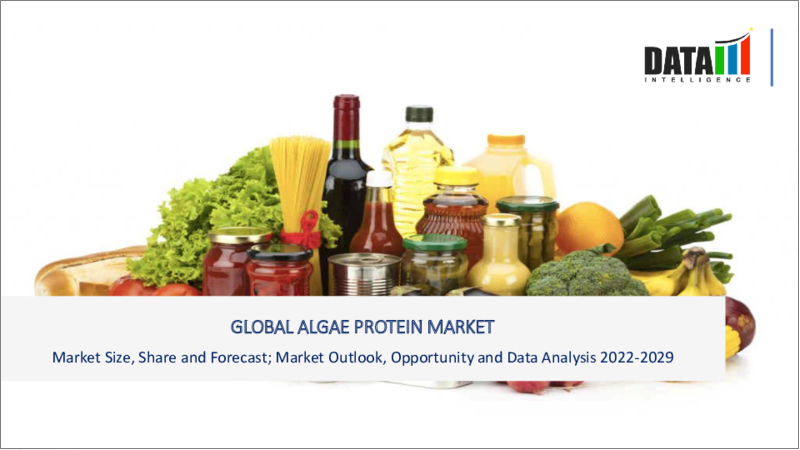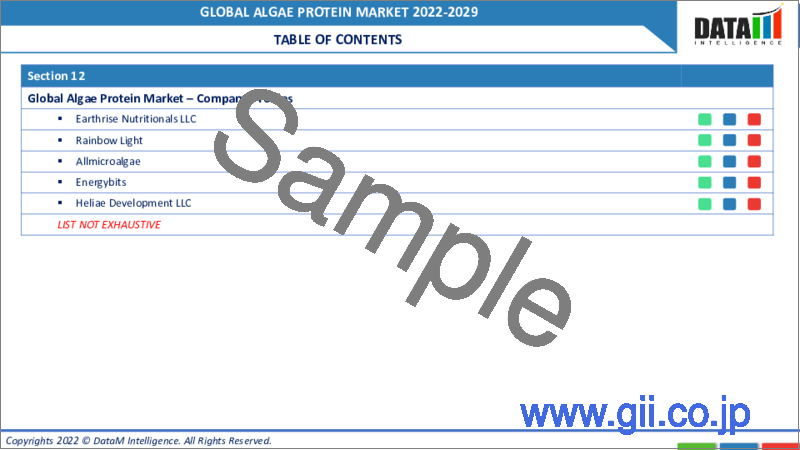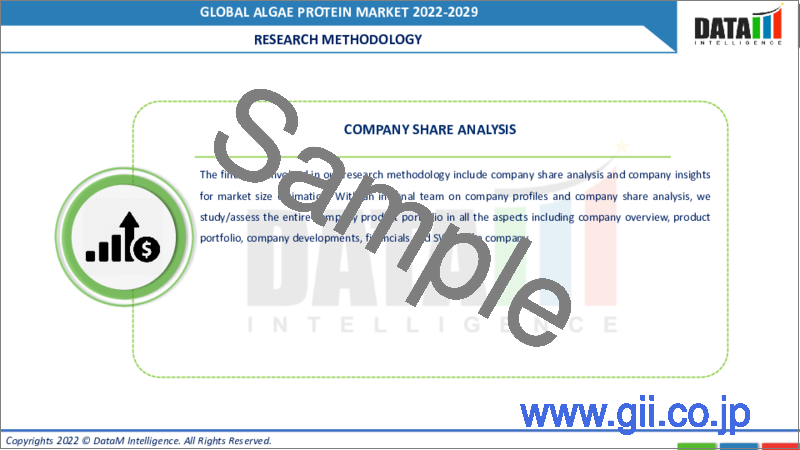|
|
市場調査レポート
商品コード
1176586
藻類タンパク質の世界市場-2023-2030Global Algae Protein Market - 2023-2030 |
||||||
|
● お客様のご希望に応じて、既存データの加工や未掲載情報(例:国別セグメント)の追加などの対応が可能です。 詳細はお問い合わせください。 |
|||||||
| 藻類タンパク質の世界市場-2023-2030 |
|
出版日: 2022年12月26日
発行: DataM Intelligence
ページ情報: 英文 170 Pages
納期: 約2営業日
|
- 全表示
- 概要
- 目次
市場概要
藻類タンパク質は、海藻や淡水産の藻類を抽出・収穫・乾燥させることで得られます。藻類タンパク質は、良質なアミノ酸と高いタンパク質含有量により、非常に栄養価の高い食品です。飼料、栄養補助食品、飲食品などに利用されています。藻類タンパク質は、体重減少を促し、心臓病、糖尿病、疲労を予防するために販売されています。また、ライフスタイルの変化や消費者の健康意識の高まりにより、世界的にタンパク質製品の消費量が多いことも、藻類タンパク質市場の成長を後押ししています。
藻類タンパク質の世界市場は、予測期間(2023-2030年)にはCAGR8.12%で成長すると予測されています。
市場力学:健康への関心の高まりと必須タンパク質・栄養素の利用可能性
消費者の間食に対する意識は高まっており、藻類タンパク質のような代謝に優れた健康的な食品を取り入れる傾向が強まっています。また、これらのスナックは体に重要なビタミンや栄養素を供給するため、ヘルシースナッキングは減量のための補助食品として高く評価されています。予測期間中、世界の藻類タンパク質市場は、体重管理と健康的な間食に対する需要の増加によって牽引されると予想されます。
European Algae Biomass Associationによると、2050年までに、世界は100億人の人口を養うために70%以上の食料を生産する必要があります。これらの食品は、環境への影響を軽減しながら、高い栄養基準を満たす必要があります。ユニリーバ・フード・ソリューションズ社とアルジェニュイティ社は、この新しい食糧システムへの移行において、微細藻類のような多様な植物由来のタンパク質が重要な役割を果たすと認識しています。クロレラ(Chlorella Vulgaris)は、広く認識されている(微細)藻類で、栄養豊富な、環境負荷の低いタンパク質と繊維の植物性供給源です。クロレラは、抗酸化物質、ビタミン、ミネラル、必須脂肪酸を含むいくつかの追加の有益な栄養素を有しています。しかし、クロレラはクロロフィル(葉緑素)を多く含み、緑色で苦味と臭いがあるため、主流の食生活に取り入れるには障害となっています。これらの要因は、藻類タンパク質市場を牽引する可能性があります。
幅広いタンパク質代替品の利用可能性が、食品における藻類タンパク質の使用を阻害する可能性があります。藻類は、一般的な栄養素やタンパク質の供給源として浮上しており、強化食品に添加されているが、異なるタンパク質ベースの食品の存在が重要な課題です。さらに、植物性タンパク質やビーガン食品の代替品へのシフトが進んでいるにもかかわらず、多くの人々にとって肉は依然として食生活の重要な部分を占めています。例えば、Food Research Internationalに掲載されたEU5カ国の4322人の回答者を対象とした調査によると、回答者の40%が動物由来の食品に傾倒したままで、植物由来の代替食品に切り替えることへの関心は比較的低いです。
市場セグメンテーション:藻類タンパク質の世界市場では、スピルリナ藻類タイプのセグメントが最も高いシェアを占めています
スピルリナは、スムージーやプロテインシェイクに豊かな緑色を提供します。この藻類は、抗炎症作用を持ちながら、コレステロールの低下を助けるので、心臓の健康に最適です。その高いビタミン含有量のために、スピルリナは、広範囲にスポーツ栄養製品のために商業化されています。スピルリナは、乾燥重量で約50%~70%のタンパク質を含む、植物性食品の高タンパク源です。スピルリナは核酸含有量が少なく、ビタミンやミネラルを多く含み、他の微生物と比較して細胞壁の消化が良いことから、様々な食品・飼料メーカーに注目されています。動物用飼料もスピルリナを多量に含んでおり、今後の強力な高騰市場となっています。
液体状の藻類タンパク質の消費は、そのようなビタミン、抗酸化物質、アミノ酸、必須栄養素の広い範囲の容易な吸収など、多くの利点を提供しています。複数の食品・飲料メーカーが藻類を加えて、ユニークな栄養補給を提案しています。例えば、2022年2月、フルはスピルリナを使用して栄養価を高めた健康飲料「フル・ソーダ」を発売しました。さらに、植物由来の乳製品の開発は、藻類の使用に有利な範囲を提供します。シンガポールを拠点とするフードテック企業、ソフィーズ・バイオニュートリエンツは2021年5月4日、乳糖不耐症やその他のアレルギーに伴う懸念を払拭し、世界初の藻類ミルクを発表しました。この代替ミルクには、微細藻類と同じ必須アミノ酸を含むSophie's Bionutrients社独自の微細藻類タンパク質粉が使用されています。この粉を水と一緒にホモジナイズすることで、乳製品を含まない代替食品ができあがります。
地理的浸透:予測期間中、アジア太平洋地域が圧倒的なシェアを獲得
アジア太平洋地域は、輸出の増加や植物由来成分の国内需要が世界の藻類タンパク質市場の成長を促進しているため、予測期間中に最も成長率の高い地域市場として浮上することが予想されます。食生活の変化は、ベーカリーや菓子類、プロテインドリンク、朝食シリアル、スナック、その他多くの製品に藻類タンパク質を利用することをメーカーに促しています。タンパク質ベースのダイエットへの消費者の傾斜の増加と、毎日の食事に植物性または天然成分を含めることは、アジアでの藻タンパク質の採用を後押ししています。
中国は、原材料の入手が容易であることから、この地域最大の植物由来原料メーカーの1つとなっています。食糧農業機関によると、海藻類として知られる海洋性大型藻類を主体とする世界の藻類栽培は、2019年の3460万トンから2020年には50万トン増加し、1.4%増となりました。中国や日本を含む一部の主要生産国は、2020年に成長を遂げました。水生動物の1億7800万トンに加え、2020年には藻類が3600万トン(湿重量)を生産し、そのうちの97%が養殖に由来しています。藻類の生産量は、2000年に1200万トン、2010年に2100万トンと、過去数十年で目覚ましい成長を遂げています。しかし、2020年には2019年と比較してわずか2%しか増加しませんでした。アジア諸国は、藻類の総生産量の97パーセントのシェアを持ち、主要生産国としての役割を確認しました。5フィンフィッシュの残りの6パーセントはディアドローマ種で構成されていました。主要生産国として、2020年には中国だけで全体の58パーセントを占め、次いでインドネシア(27パーセント)、韓国(5パーセント)となっています。
目次
第1章 調査手法と範囲
- 調査手法
- 市場の範囲
第2章 主な動向と発展
第3章 エグゼクティブサマリー
- 製品別市場内訳
- 形態別市場内訳
- アプリケーション別市場内訳
- 地域別市場内訳
第4章 市場力学
- 市場影響要因
- 促進要因
- 抑制要因
- ビジネスチャンス
- 影響分析
第5章 産業分析
- ポーターのファイブフォース分析
- サプライチェーン分析
- 特許分析
- 規制分析
第6章 COVID-19の分析
- COVID-19の市場に関する分析
- COVID-19以前の市場シナリオ
- COVID-19の現在の市場シナリオ
- COVID-19の後、または将来のシナリオ
- COVID-19の中での価格ダイナミクス
- 需要-供給スペクトラム
- パンデミック時の市場に関連する政府の取り組み
- メーカーの戦略的取り組み
第7章 製品別
- スピルリナ
- クロレラ
- 海藻類
- その他
第8章 形態別
- 粉末
- 液状
- カプセル
第9章 アプリケーション別
- 飲食品
- 栄養補助食品
- 動物用飼料
- 化粧品
第10章 地域別
- 北米
- 米国
- カナダ
- メキシコ
- 南米
- ブラジル
- アルゼンチン
- その他の南米地域
- 欧州
- ドイツ
- 英国
- フランス
- スペイン
- イタリア
- その他の欧州地域
- アジア太平洋地域
- 中国
- インド
- 日本
- オーストラリア
- その他アジア太平洋地域
- 中東・アフリカ地域
第11章 競合情勢
- 競合シナリオ
- 競合の戦略分析
- 市況/シェア分析
- M&A(合併・買収)分析
第12章 企業プロファイル
- Carbion Biotech Inc.
- 企業概要
- 製品ポートフォリオと説明
- 主なハイライト
- 財務概要
- Nutress
- Nutrex Hawaii Inc.
- Cyanotech Corporation
- Far East Bio-Tech Co Ltd.
- Earthrise Nutritionals LLC
- Rainbow Light
- Allmicroalgae
- Energybits
- Heliae Development LLC
第13章 DataM
Market Overview
Algae proteins are derived from marine algae and freshwater algae by extracting, harvesting, and drying the algae. They have an extremely nutritious profile due to the good quality of amino acids and high protein content. They are used in preparing animal feeds, dietary supplements, and food beverages. Algae protein is marketed to encourage weight loss and prevent heart disease, diabetes, and fatigue. Moreover, the high consumption of protein products worldwide due to changes in lifestyles and the rise in health consciousnesses among consumers is also lifting the growth of the algae protein market.
The global algae protein market was valued at USD YY million in 2022. It is forecasted to reach USD YY million by 2030, growing at a CAGR of 8.12% during the forecast period (2023-2030).
Market Dynamics: Increasing health concerns and the availability of essential proteins and nutrients
Consumers are becoming more conscious of their snacking habits and are increasingly adopting healthier foods such as algae protein due to their metabolic benefits. Healthy snacking is also well-regarded as a supplement to weight loss, as these snacks provide the body with important vitamins and nutrients. Over the forecast period, the global algae protein market is expected to be driven by growing demand for weight control and healthy snacking.
According to European Algae Biomass Association, by 2050, the world will need to produce 70% more food to feed a population of 10 billion people. These foods will need to meet a high nutritional standard while reducing their impact on the environment. The companies Unilever Food Solutions and Algenuity recognize the key role that diverse, plant-based proteins like microalgae will play in transitioning toward this new food system. Chlorella Vulgaris, a widely recognized (micro)algae, is a nutrient-rich, plant-based source of protein and fiber with a low environmental footprint. Chlorella possesses several additional beneficial nutrients, including antioxidants, vitamins, minerals and essential fatty acids. It has been consumed globally for many years, yet its high chlorophyll content, which gives plants their green color and a bitter taste and smell, has proven a barrier to its inclusion in mainstream diets. These factors may drive the algae protein market.
The availability of a wide range of protein substitutes may impede the use of algae proteins in food products. While algae are emerging as a popular source of nutrients and proteins and are being added to fortified food products, the presence of different protein-based food products is a key challenge. Additionally, meat remains a crucial part of the diet for many people, despite the ongoing shift toward plant-based protein and vegan food alternatives. For instance, according to a survey published in Food Research International involving 4322 respondents across 5 EU countries, 40% of those respondents remained inclined towards animal-based foods with relatively low interest in switching to plant alternatives.
Market Segmentation: The spirulina algae type segment had the highest share in the global algae protein market
Spirulina provides a rich green color to smoothies and protein shakes. This algae is great for heart health as it helps lower cholesterol while having anti-inflammatory effects. Due to its high vitamin content, spirulina is extensively commercialized for sports nutrition products. Spirulina is a high-protein source of plant-based foods, containing approximately 50% to 70% protein by dry weight. Spirulina's low nucleic acid content, high vitamin and mineral content, and easy digestibility of the cell wall relative to other microbes have attracted a variety of food and feed manufacturers. Animal feed also contains high amounts of spirulina, making it a strong and soaring market in the coming future.
Consumption of algae protein in liquid form offers many benefits, such as easy absorption of a wide range of vitamins, antioxidants, amino acids, and essential nutrients. Multiple foods and beverage companies are adding algae to introduce unique nutritional offerings. For instance, in February 2022, Ful launched Ful Soda, a healthy drink that uses spirulina to provide a nutritional boost. Furthermore, developments in plant-based dairy will offer lucrative scope for the use of algae. The Singapore-based food tech company, on 4 May 2021, Sophie's Bionutrients introduced the world's first-ever algae milk, eliminating the concerns associated with lactose intolerance and other allergies. The milk replacement is made with Sophie's Bionutrients signature micro-algae protein flour with the same essential amino acids as micro-algae. The flour is then homogenized with water to create a dairy-free alternative.
Geographical Penetration: Asia Pacific the dominating region during the forecast period
Asia Pacific is expected to emerge as the fastest-growing regional market over the forecast period due to rising exports and domestic demand for plant-based ingredients are driving the growth of the global algae protein market. Changing dietary patterns has encouraged manufacturers to utilize algae proteins in bakery & confectionery, protein drinks, breakfast cereals, snacks, and many other products. Growing consumer inclination towards protein-based diets and the inclusion of plant-based or natural ingredients into daily diets have boosted the adoption of algae protein in Asia.
China is one of the region's largest manufacturers of plant-based ingredients due to the easy obtainability of raw materials in the country. According to Food and Agriculture Organization, global cultivation of algae, dominated by marine macroalgae known as seaweeds, grew by half a million tonnes in 2020, up by 1.4 percent from 34.6 million tonnes in 2019. Some major producing countries, including China and Japan, experienced growth in 2020. In addition to the 178 million tonnes of aquatic animals, algae produced 36 million tonnes (wet weight) in 2020, of which 97 percent originated from aquaculture. Algae production has experienced impressive growth in the past few decades, at 12 million tonnes in 2000 and 21 million tonnes in 2010. However, it increased by only 2 percent in 2020 compared with 2019. Asian countries confirmed their role as major producers, with a share of 97 percent of the total production of algae. 5 The remaining 6 percent of finfish comprised diadromous species. As the leading producer, China alone accounted for 58 percent of the overall total in 2020, followed by Indonesia (27 percent) and the Republic of Korea (5 percent).
Competitive Landscape:
The global algae protein market is competitive in nature, with many domestic and multinational players competing for market share. Emphasis is given to the merger, expansion, acquisition, and partnership of the companies, along with new product development, as strategic approaches adopted by the leading companies to boost their brand presence among consumers. Some major global key players in the algae protein market include Carbion Biotech Inc., Nutress, Nutrex Hawaii Inc., Cyanotech Corporation, Far East Bio-Tech Co Ltd., Earthrise Nutritionals LLC, Rainbow Light, Allmicroalgae, Energybits and Heliae Development LLC. Further, market key players are also planning to strengthen their distribution relationships with firms across various regions by merging or acquiring to leverage the customer base for future product launches.
For instance, on 14 June 2021, the company Polaris launched Omegavie DHA 800 Qualitysilver algae oil, designed to answer challenges in the value chain, including R&D and regulatory concerns. These microorganisms comprise vitamins, proteins, pigments, and enzymes, providing PUFAs from plant-based and sustainable origins. In July 2020, the companies Unilever and biotech start-up Algenuity announced a new partnership to delve into the huge potential of microalgae in innovating future foods for Unilever's plant-based portfolio. Algenuity, which specializes in developing microalgae for consumer products, will work with the R&D team within Unilever's Foods and Refreshment (F&R) division to explore ways of bringing foods made with microalgae to the market.
COVID-19 Impact: Positive impact on the global algae protein market
The onset of the COVID-19 pandemic prompted research activities to identify effective solutions to combat the coronavirus infection. Some studies suggested that algal nutraceuticals could act as immune boosters against COVID-19 and other viral illnesses. Subsequently, the increased importance of algal nutraceuticals, particularly spirulina-based products, has augmented consumer demand, which has played a vital role in industry expansion during the pandemic.
Algae is used as one type of medicine for the virus in the pandemic in some areas. It also positively impacted the global algae protein market to increase demand. For instance, MIGAL Galilee Research Institute used algae at a lab in Iceland by Israeli company Vaxa, which received European Union funding to explore natural treatments for Covid-19. The research indicated that when the algae extracted was included in optimum quantities. There was a 70% reduction in the release of TNF-α proteins, which is very encouraging that the algae extract might be used to prevent cytokine storms if given to patients soon after diagnosis.
The global algae protean market report would provide access to approximately 61 market data tables, 53 figures and 170 pages.
Algae production, consumption, and export are high all over the Asia Pacific region. It pushes novel and veteran players to join the market or expand their product lines using these algae. The footprint of algae-based products is primed for growth in Asia-Pacific in the coming years. The market for algae-based products is moving upward with good momentum. Although algae are quite a phenomenon in Asia-Pacific, slowly and steadily, their roots have spread to Europe and North America.
Table of Contents
1. Scope and Methodology
- 1.1. Research Methodology
- 1.2. Scope of the Market
2. Key Trends and Developments
3. Executive Summary
- 3.1. Market Snippet by Product
- 3.2. Market Snippet by Form
- 3.3. Market Snippet by Application
- 3.4. Market Snippet by Region
4. Market Dynamics
- 4.1. Market impacting factors
- 4.1.1. Drivers
- 4.1.2. Restraints
- 4.1.3. Opportunities
- 4.2. Impact analysis
5. Industry Analysis
- 5.1. Porter's five forces analysis
- 5.2. Supply Chain Analysis
- 5.3. Patent Analysis
- 5.4. Regulatory Analysis
6. COVID-19 Analysis
- 6.1. Analysis of Covid-19 on the Market
- 6.1.1. Before COVID-19 Market Scenario
- 6.1.2. Present COVID-19 Market Scenario
- 6.1.3. After COVID-19 or Future Scenario
- 6.2. Pricing Dynamics Amid Covid-19
- 6.3. Demand-Supply Spectrum
- 6.4. Government Initiatives Related to the Market During the Pandemic
- 6.5. Manufacturers Strategic Initiatives
7. By Product
- 7.1. Introduction
- 7.1.1. Market size analysis, and y-o-y growth analysis (%), By Product Segment
- 7.1.2. Market attractiveness index, By Product Segment
- 7.2. Spirulina
- 7.2.1. Introduction
- 7.2.2. Market Size Analysis, US$ Million, 2020-2029 And Y-O-Y Growth Analysis (%), 2021-2029
- 7.3. Chlorella
- 7.4. Seaweed
- 7.5. Others
8. By Form
- 8.1. Introduction
- 8.1.1. Market size analysis, and y-o-y growth analysis (%), By Form Segment
- 8.1.2. Market attractiveness index, By Form Segment
- 8.2. Powder*
- 8.2.1. Introduction
- 8.2.2. Market Size Analysis, US$ Million, 2020-2029 And Y-O-Y Growth Analysis (%), 2021-2029
- 8.3. Liquid
- 8.4. Capsules
9. By Application
- 9.1. Introduction
- 9.1.1. Market size analysis, and y-o-y growth analysis (%), By Application Segment
- 9.1.2. Market attractiveness index, By Application Segment
- 9.2. Food and Beverage*
- 9.2.1. Introduction
- 9.2.2. Market Size Analysis, US$ Million, 2020-2029 And Y-O-Y Growth Analysis (%), 2021-2029
- 9.3. Dietary Supplements
- 9.4. Animal Feed
- 9.5. Cosmetics
10. By Region
- 10.1. Introduction
- 10.1.1. Market Size Analysis, And Y-O-Y Growth Analysis (%), By Region
- 10.1.2. Market Attractiveness Index, By Region
- 10.2. North America
- 10.2.1. Introduction
- 10.2.2. Key region-specific dynamics
- 10.2.3. Market Size Analysis, And Y-O-Y Growth Analysis (%), By Product
- 10.2.4. Market Size Analysis, And Y-O-Y Growth Analysis (%), By Form
- 10.2.5. Market Size Analysis, And Y-O-Y Growth Analysis (%), By Application
- 10.2.6. Market Size Analysis, And Y-O-Y Growth Analysis (%), By Country
- 10.2.6.1. U.S.
- 10.2.6.2. Canada
- 10.2.6.3. Mexico
- 10.3. South America
- 10.3.1. Introduction
- 10.3.2. Key Region-Specific Dynamics
- 10.3.3. Market Size Analysis, And Y-O-Y Growth Analysis (%), By Product
- 10.3.4. Market Size Analysis, And Y-O-Y Growth Analysis (%), By Form
- 10.3.5. Market Size Analysis, And Y-O-Y Growth Analysis (%), By Application
- 10.3.6. Market Size Analysis, And Y-O-Y Growth Analysis (%), By Country
- 10.3.6.1. Brazil
- 10.3.6.2. Argentina
- 10.3.6.3. Rest of South America
- 10.4. Europe
- 10.4.1. Introduction
- 10.4.2. Key Region-Specific Dynamics
- 10.4.3. Market Size Analysis, And Y-O-Y Growth Analysis (%), By Product
- 10.4.4. Market Size Analysis, And Y-O-Y Growth Analysis (%), By Form
- 10.4.5. Market Size Analysis, And Y-O-Y Growth Analysis (%), By Application
- 10.4.6. Market Size Analysis, And Y-O-Y Growth Analysis (%), By Country
- 10.4.6.1. Germany
- 10.4.6.2. U.K.
- 10.4.6.3. France
- 10.4.6.4. Spain
- 10.4.6.5. Italy
- 10.4.6.6. Rest of Europe
- 10.5. Asia Pacific
- 10.5.1. Introduction
- 10.5.2. Key Region-Specific Dynamics
- 10.5.3. Market Size Analysis, And Y-O-Y Growth Analysis (%), By Product
- 10.5.4. Market Size Analysis, And Y-O-Y Growth Analysis (%), By Form
- 10.5.5. Market Size Analysis, And Y-O-Y Growth Analysis (%), By Application
- 10.5.6. Market Size Analysis, And Y-O-Y Growth Analysis (%), By Country
- 10.5.6.1. China
- 10.5.6.2. India
- 10.5.6.3. Japan
- 10.5.6.4. Australia
- 10.5.6.5. Rest of Asia Pacific
- 10.6. Middle East and Africa
- 10.6.1. Introduction
- 10.6.2. Key Region-Specific Dynamics
- 10.6.3. Market Size Analysis, And Y-O-Y Growth Analysis (%), By Product
- 10.6.4. Market Size Analysis, And Y-O-Y Growth Analysis (%), By Form
- 10.6.5. Market Size Analysis, And Y-O-Y Growth Analysis (%), By Application
11. Competitive Landscape
- 11.1. Competitive scenario
- 11.2. Competitor strategy analysis
- 11.3. Market positioning/share analysis
- 11.4. Mergers and acquisitions analysis
12. Company Profiles
- 12.1. Carbion Biotech Inc.*
- 12.1.1. Company Overview
- 12.1.2. Product Portfolio and Description
- 12.1.3. Key Highlights
- 12.1.4. Financial Overview
- 12.2. Nutress
- 12.3. Nutrex Hawaii Inc.
- 12.4. Cyanotech Corporation
- 12.5. Far East Bio-Tech Co Ltd.
- 12.6. Earthrise Nutritionals LLC
- 12.7. Rainbow Light
- 12.8. Allmicroalgae
- 12.9. Energybits
- 12.10. Heliae Development LLC
13. DataM
- 13.1. Appendix
- 13.2. About us and services
- 13.3. Contact us




